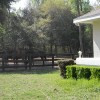 Equine facilities have unique pest management problems due to facility structure and horse husbandry practices. In Florida, homes on small equine farms are generally located in close proximity to pastures, stalls or run-in sheds, manure piles, and other fly breeding habitats. So homeowners have a high risk of exposure to pathogens that can be transmitted by filth flies to humans. Integrated pest management for equine farms requires accurate diagnosis of pest problems and the coordinated use of science-based management practices, but a recent survey shows that many equine property owners don’t know enough about the identification, biology, and presence of filth fly pests on their properties to develop successful IPM programs. This 7-page fact sheet was written by Erika T. Machtinger, Norman C. Leppla, and Cindy Saunders, and published by the UF Department of Entomology and Nematology, March 2013.
Equine facilities have unique pest management problems due to facility structure and horse husbandry practices. In Florida, homes on small equine farms are generally located in close proximity to pastures, stalls or run-in sheds, manure piles, and other fly breeding habitats. So homeowners have a high risk of exposure to pathogens that can be transmitted by filth flies to humans. Integrated pest management for equine farms requires accurate diagnosis of pest problems and the coordinated use of science-based management practices, but a recent survey shows that many equine property owners don’t know enough about the identification, biology, and presence of filth fly pests on their properties to develop successful IPM programs. This 7-page fact sheet was written by Erika T. Machtinger, Norman C. Leppla, and Cindy Saunders, and published by the UF Department of Entomology and Nematology, March 2013.
http://edis.ifas.ufl.edu/in983
Tag: Erika Machtinger
Eye Gnats, Grass Flies, Eye Flies, Fruit Flies Liohippelates spp. (Insecta: Diptera: Chloropidae) (EENY485/IN884)
High concentrations of eye gnats are common in areas that have loose sandy soils, especially in the southern United States, and are a great nuisance to humans and animals in rural towns as well as agricultural, recreational, and tourist areas. While they do not bite, they can transmit several diseases to humans and livestock, including human acute conjunctivitis (pink eye). This 6-page fact sheet focuses broadly on two species that are common in the southeastern region of the United States are L. pusio and L. bishoppi (Sabrosky). Written by Erika Machtinger and Phillip E. Kaufman and published by the UF Department of Entomology and Nematology, April 2011.
http://edis.ifas.ufl.edu/in884